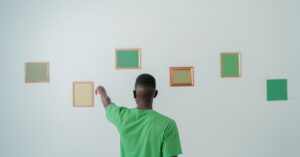Revamping old furniture doesn’t have to be a daunting task. Enter chalk paint, the superhero of the DIY world, ready to rescue tired pieces from the depths of drabness. With its velvety texture and matte finish, chalk paint transforms furniture into eye-catching masterpieces faster than you can say “upcycle.”
Table of Contents
ToggleOverview of Chalk Paint Furniture
Chalk paint furniture offers a simple way to breathe new life into old pieces. This paint type features a unique velvety texture and a matte finish that many find appealing. Minimal prep work is necessary, making it accessible for DIY enthusiasts of all skill levels. Unlike traditional paints, applying chalk paint doesn’t require extensive sanding or priming.
Colors abound in the chalk paint market, with popular shades including soft pastels, muted tones, and classic neutrals. These colors allow for diverse styles, from rustic farmhouse to modern chic. Finishing touches such as wax or varnish can enhance durability, providing a protective layer against wear and tear.
Changing the appearance of furniture with chalk paint not only improves aesthetics but also promotes sustainability. Choosing to refurbish old furniture reduces waste and fosters an eco-friendly mindset. The ability to customize each piece encourages creativity and unique expressions of personal style.
Versatility remains a key feature of chalk paint. It adheres well to various surfaces including wood, metal, and even plastic. Consequently, furniture pieces can transform dramatically in just a few hours, offering instant gratification for the painter.
Chalk paint doesn’t just enhance beauty; it can also add texture. Layering techniques or distressing methods create depth and character, making furniture one-of-a-kind. With proper application and creativity, homeowners can showcase their vision through beautifully revamped furniture that serves both function and style.
Benefits of Using Chalk Paint
Chalk paint offers several advantages that elevate furniture upcycling. Numerous attributes contribute to its popularity among DIY enthusiasts.
Easy Application
Applying chalk paint is straightforward. It adheres to various surfaces without extensive prep work. Minimal sanding is necessary, making it accessible for all skill levels. Users appreciate that it glides smoothly, allowing for quick coverage. Increased flexibility comes from its ability to be used on wood, metal, and even plastic. With just a few brushes, transforming furniture becomes an enjoyable experience. The seamless experience often encourages creativity, resulting in personalized designs.
Fast Drying Time
Chalk paint dries quickly, which is a significant advantage for busy DIYers. Most brands dry to the touch within one to two hours. This fast drying time allows for multiple coats in a single day. Projects can progress swiftly, making it ideal for those on tight schedules. The quick turnaround often inspires more furniture makeovers in shorter spans. Additionally, the rapid drying characteristic means less time spent waiting and more time enjoying the finished piece. With chalk paint, immediate gratification becomes a reality for furniture transformations.
Popular Brands of Chalk Paint
Several brands of chalk paint stand out for their quality and variety, each catering to specific needs and preferences.
Brand A
Annie Sloan is renowned for revolutionizing the chalk paint market. This brand offers a wide palette of over 40 colors, providing options that suit any style. Annie Sloan Chalk Paint requires no priming or sanding, making it user-friendly. Its unique formula allows for easy blending, enabling creative DIY projects. Many users appreciate the smooth finish and excellent coverage, which minimizes the need for multiple coats. In addition, her waxes and finishes enhance durability, extending the life of the painted furniture.
Brand B
Rust-Oleum chalked paint is another popular choice among DIY enthusiasts. This brand provides an affordable option while maintaining quality and performance. Rust-Oleum’s paint adheres well to wood, metal, and more, making it versatile for various projects. It comes in several trendy colors, catering to modern and traditional aesthetics. The chalked finish dries to a velvety texture, ideal for a farmhouse look. Users often note its quick drying time, allowing for swift furniture transformations.
Techniques for Applying Chalk Paint
Applying chalk paint involves specific techniques that enhance the furniture’s appearance and longevity. Understanding these methods can lead to impressive results.
Preparation of Furniture
Preparing furniture before applying chalk paint ensures optimal adhesion and finish. Start by cleaning surfaces to remove dust and grease. Any imperfections should be lightly sanded to create a smooth base. Examine for previous coatings; if present, simple cleaning often suffices. After that, wipe down with a damp cloth to remove any sanding dust. Skipping this step may lead to uneven results. Using a primer isn’t necessary, but it can improve color depth for lighter shades. Overall, taking these steps sets the stage for a successful transformation.
Layering and Distressing
Layering provides a depth not easily achieved with a single coat of paint. Begin with a base color; once it dries, add additional layers for a richer finish. Achieving a desired texture often requires sanding between layers. Distressing, meanwhile, adds character to the piece. To distress, focus on edges and areas that naturally wear over time. Lightly sand these spots to reveal the base coat beneath. Combining both layering and distressing techniques results in a unique piece that showcases creativity and personal style.
Maintenance Tips for Chalk Paint Furniture
Maintaining chalk paint furniture ensures longevity and keeps surfaces looking fresh. Regular dusting using a soft cloth prevents buildup and helps maintain the matte finish. Cleaning spills promptly with a damp cloth minimizes potential damage and staining.
Applying a wax or varnish topcoat enhances durability, offering additional protection against wear. This step locks in color depth, adding a subtle sheen while shielding against everyday usage. Resealing every six months supports ongoing preservation, especially in high-traffic areas.
When dealing with scratches or marks, light sanding can help restore surfaces. Sand lightly, then reapply a touch of paint for seamless repairs. This method is efficient for minor touch-ups without the need for a full repaint.
Avoid heavy cleaners or chemical solutions, as these can dull the finish and damage the paint. Instead, opt for gentle soap solutions that clean without harsh effects. Maintaining proper humidity levels in the environment also benefits chalk paint furniture, preventing cracking or peeling.
Consider moving furniture away from direct sunlight to minimize fading. Positioning items strategically protects the color integrity while prolonging their appeal. Parquet flooring protection prevents scuffs and scratches from furniture movement.
Chalk paint furniture thrives on care and attention. Following these maintenance tips helps retain charm and character, ensuring pieces continue to enhance interiors for years. By giving attention to detail, furniture remains beautiful, functional, and sustainable.
Revamping furniture with chalk paint opens up a world of creative possibilities. Its user-friendly application and quick drying time make it an ideal choice for both beginners and seasoned DIYers. The range of colors and techniques available allows for unique transformations that reflect personal style.
By choosing chalk paint, individuals not only breathe new life into old furniture but also contribute to sustainable practices by reducing waste. With proper maintenance, these revitalized pieces can remain beautiful and functional for years. Embracing chalk paint can truly turn any furniture project into a rewarding experience.




